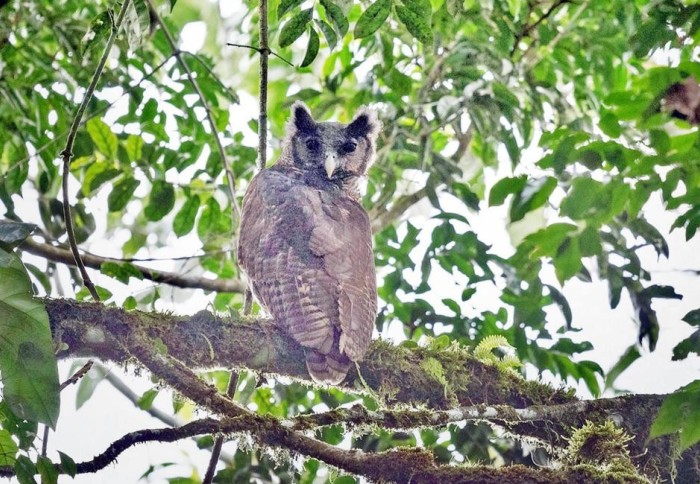Owl unseen for 150 years photographed in the wild for the first time

Shelley’s Eagle Owl. Credit: Dr Robert Williams
British scientists working in Ghana have photographed a ‘holy grail’ giant owl that has lurked almost unseen in African rainforests for 150 years.
Shelley’s Eagle Owl was spotted by Dr Joseph Tobias, from the Department of Life Sciences (Silwood Park) at Imperial College London and leader of a UK-government funded field project studying biological impacts of agricultural development in Africa, and Dr Robert Williams, a freelance ecologist from Somerset.
When we lifted our binoculars our jaws dropped. There is no other owl in Africa’s rainforests that big. Dr Joseph Tobias
The bird was first described in 1872 from a specimen obtained from a local hunter in Ghana by Richard Bowdler Sharpe, curator of the bird collection at the Natural History Museum in London and founder of the British Ornithologists’ Club.
There have been no confirmed sightings from Ghana since the 1870s, and very few glimpses elsewhere. The only photographs in existence were grainy images taken in 1975 of a captive individual behind bars at Antwerp zoo and a pixelated blob from Congo in 2005 that is not certainly the right species.
There have been occasional reports over recent decades from people believing they have heard or briefly seen Shelley’s Eagle Owl from a few different localities across West and Central Africa from Liberia to Angola. Most of these sightings are unconfirmed, and the species has become a holy grail for birdwatchers in Africa and beyond.
Large and distinctive
This all changed on 16 October 2021 when Dr Tobias and Dr Williams visited Atewa forest in Ghana and disturbed a huge bird from its daytime roost. “It was so large, at first we thought it was an eagle,” Dr Tobias said. “Luckily it perched on a low branch and when we lifted our binoculars our jaws dropped. There is no other owl in Africa’s rainforests that big.”
Hopefully, the discovery of such a rare and magnificent owl will boost these efforts to save one of the last wild forests in Ghana. Dr Robert Williams
The pair only saw the bird perched for 10-15 seconds but in that time managed to take photographs that confirm the identification due to its distinctive black eyes, yellow bill, and huge size, which in combination rule out all other African forest owls.
The fact that a predator of such massive size had become essentially invisible over a large swathe of Africa fuelled speculation as to its current whereabouts and reasons for its apparent rarity.
Dr Nathaniel Annorbah of University of Environment and Sustainable Development, Ghana, said: “This is a sensational discovery. We’ve been searching for this mysterious bird for years in the western lowlands, so to find it here in ridgetop forests of Eastern Region is a huge surprise.”
New hope
Shelley’s Eagle Owl is officially classified as vulnerable to extinction with an estimated population of a few thousand individuals. The news of its continued survival in Ghana offers new hope for the species.
Although the Atewa site is threatened by illegal logging and bauxite mining, higher elevations still support large areas of evergreen forest. Environmental groups, such as the Friends of Atewa, are lobbying for the area to be designated as a national park.
Dr Williams said: “We hope this sighting draws attention to Atewa forest and its importance for conserving local biodiversity. Hopefully, the discovery of such a rare and magnificent owl will boost these efforts to save one of the last wild forests in Ghana.”
Article text (excluding photos or graphics) © Imperial College London.
Photos and graphics subject to third party copyright used with permission or © Imperial College London.
Reporter
Hayley Dunning
Communications Division